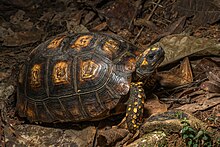| Yellow-footed tortoise | |
|---|---|

| |
| Yellow-footed tortoise, Yasuni National Park, Ecuador | |
| Scientific classification | |
| Domain: | Eukaryota |
| Kingdom: | Animalia |
| Phylum: | Chordata |
| Class: | Reptilia |
| Order: | Testudines |
| Suborder: | Cryptodira |
| Superfamily: | Testudinoidea |
| Family: | Testudinidae |
| Genus: | Chelonoidis |
| Species: | C. denticulatus
|
| Binomial name | |
| Chelonoidis denticulatus (Linnaeus, 1766)
| |
| Synonyms[1] | |
| |
The yellow-footed tortoise (Chelonoidis denticulatus), also known as the Brazilian giant tortoise,[2] is a species of tortoise in the family Testudinidae and is closely related to the red-footed tortoise (C. carbonarius). It is found in the Amazon Basin of South America. The species name has often been misspelled as denticulata, an error introduced in the 1980s when Chelonoidis was elevated to genus and mistakenly treated as feminine, an error recognized and fixed in 2017.[3]
With an average length of 40 cm (15.75 in) and the largest known specimen at 94 cm (37 in), this is the sixth-largest tortoise species on Earth, after the Galapagos tortoise, the Aldabra tortoise, the African spurred tortoise (Geochelone sulcata, typical size 76 cm (30 in)), the leopard tortoise (Stigmochelys pardalis), and the Asian forest tortoise (Manouria emys emys, typical size 60 cm (23.6 in)).
- ^ Fritz Uwe; Peter Havaš (2007). "Checklist of Chelonians of the World" (PDF). Vertebrate Zoology. 57 (2): 269–270. doi:10.3897/vz.57.e30895. ISSN 1864-5755. Archived (PDF) from the original on 1 May 2011. Retrieved 29 May 2012.
- ^ "The Brazilian Giant Tortoise by M. A. Cohen" (PDF).
- ^ Turtle Taxonomy Working Group (2017). Turtles of the world : Annotated checklist and atlas of taxonomy, synonymy, distribution, and conservation status (8th Ed.) (PDF). New York: Chelonian Research Foundation. ISBN 978-1-5323-5560-8. OCLC 1124067380.
